In Nevada, there are 6 venomous species of snakes. All of these are species of rattlesnakes. In this article, we’ll describe each one of these snakes. We’ll also tell you where they live in Nevada.
First, though, since rattlesnakes are pit vipers, we’re going to talk about snakes in the pit viper family. In the section after that, we’ll talk about rattlesnakes in general.
After those two sections, we’ll talk about each individual snake species. You can skip the first two sections and go directly to the snake you’re interested in. Do this by clicking on its highlighted name.
- Southwestern Speckled Rattlesnake (Crotalus pyrrhus)
- Panamint Rattlesnake (Crotalus stephensi)
- Mojave Rattlesnake (Crotalus scutulatus)
- Mojave Desert Sidewinder (Crotalus cerastes cerastes)
- Great Basin Rattlesnake (Crotalus lutosus)
- Western Diamondback Rattlesnake (Crotalus atrox)
Pit Vipers
Rattlesnakes belong to the venomous Crotalinae or pit viper family. Other pit vipers in the United States are copperheads and cottonmouths. Pit vipers have a facial pit between their nostril and eyes on each side of their face. These pits are actually specialized organs that detect body heat from warm-blooded prey. Pit organs enable pit vipers to strike their prey precisely, even in the dark. They are also able to detect body heat from about 1 meter away.
These snakes also have a triangular head attached to a slender neck. Furthermore, the pupils of their eyes are vertical slits.
Pit vipers have hollow fangs connected to venom glands on each side of the roofs of their mouths. They use their fangs to inject venom into their prey. This venom immobilizes the prey, making it easier for the snake to consume. All pit vipers are born with multiple fangs and replace them every couple of months. Old fangs are shed one at a time. Consequently, a pit viper bite may only involve one fang.
Interestingly, these snakes have a sphincter on each venom gland. This allows them to control the flow of venom through the fangs. A snake may elect not to inject any venom with a bite. Scientists surmise that this is because it takes time for it to rebuild its venom store. Twenty to twenty-five percent of the time, a pit viper-to-human bite is a dry bite. In other words, it is venomless. Source
Pit vipers primarily consume small mammals, reptiles, amphibians, small birds, and large insects. These snakes play an important role in maintaining balance in rodent populations.
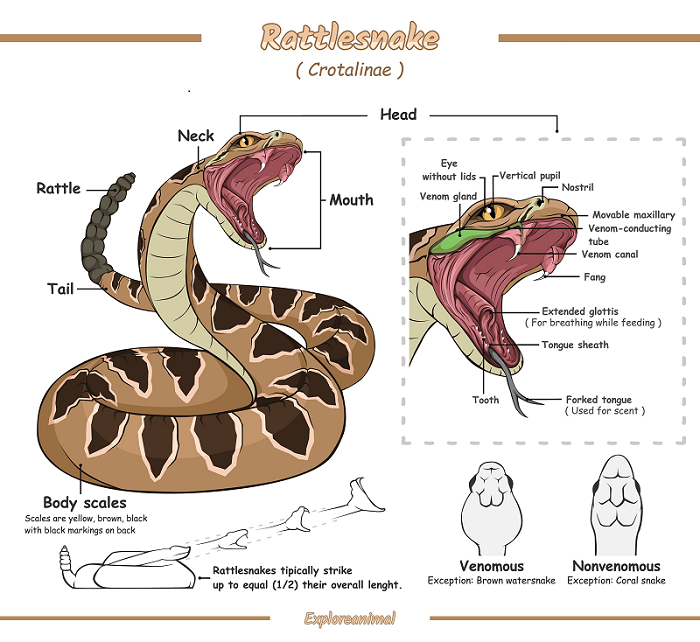
Rattlesnakes
The first thing people think about with regard to Rattlesnakes is their tails. When they are disturbed, they vibrate their tails. This makes a buzzing or a rattling-type sound.
There’s always the potential danger of rattlesnakes striking without rattling. Sometimes, their rattles fall off. You must be aware of where you are placing your hands and feet in rattlesnake country. Be vigilant when stepping over logs or large rocks. There may be a snake resting just out of site.
When you’re moving through known rattlesnake habitat you should have your dog on a leash. If you have hunting dogs, they should be wearing snake armor.
It’s a good idea to carry a long stick. You can use it to tap the ground in front of you to warn any snakes of your approach. You can also use the stick to part any dense vegetation or tall grass in your path.
If you hear a rattling noise, do not move until you spot where it’s coming from. Otherwise, you may accidentally move into the snake, provoking it to strike you.
If you are going to be hiking in rattlesnake country it would be a good idea to wear snake boots or snake gaiters. This protects your lower legs from being bitten by a snake.
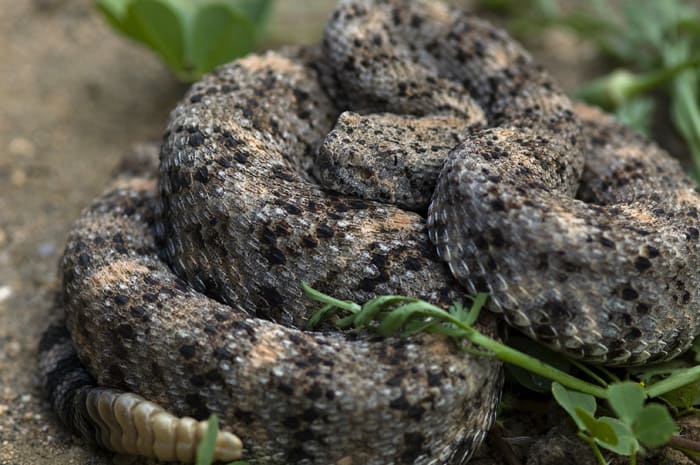
Southwestern Speckled Rattlesnake
| Scientific Name: | Crotalus pyrrhus |
| Description: | Speckled rattlesnakes are up to 39 inches (100 cm) in length. Their base color varies depending on the color of the rocks and soil in their habitat. They can be cream, tan, gray, or orange. |
| Habitat: | They prefer rocky terrain with some vegetation. |
| Conservation Status: | Species of least concern. |
Speckled rattlesnakes vary a bit in color. They can be cream, tan, grey, bluish-grey, orange, or yellowish-pink. Their bodies look speckled due to the pattern of their scales. Speckled rattlesnakes are up to 39 inches (100 cm) in length.
Other common names for this snake include Mitchell’s rattlesnake and White rattlesnake.

Where Do Speckled Rattlesnakes Live in Nevada?
The Speckled Rattlesnake is found in southeast Nevada in Clark and Lincoln Counties. They prefer rocky terrain with some vegetation.
How Dangerous Are Speckled Rattlesnakes?
A Speckled Rattlesnake’s venom is hemotoxic. It can lead to various symptoms. These include significant pain and swelling at the bite site. Nausea and vomiting might also occur. It can affect blood clotting and lead to excessive bleeding. It may induce shock, leaving the victim feeling weak and disoriented. It’s crucial to seek immediate medical help if bitten by a Speckled Rattlesnake. Source
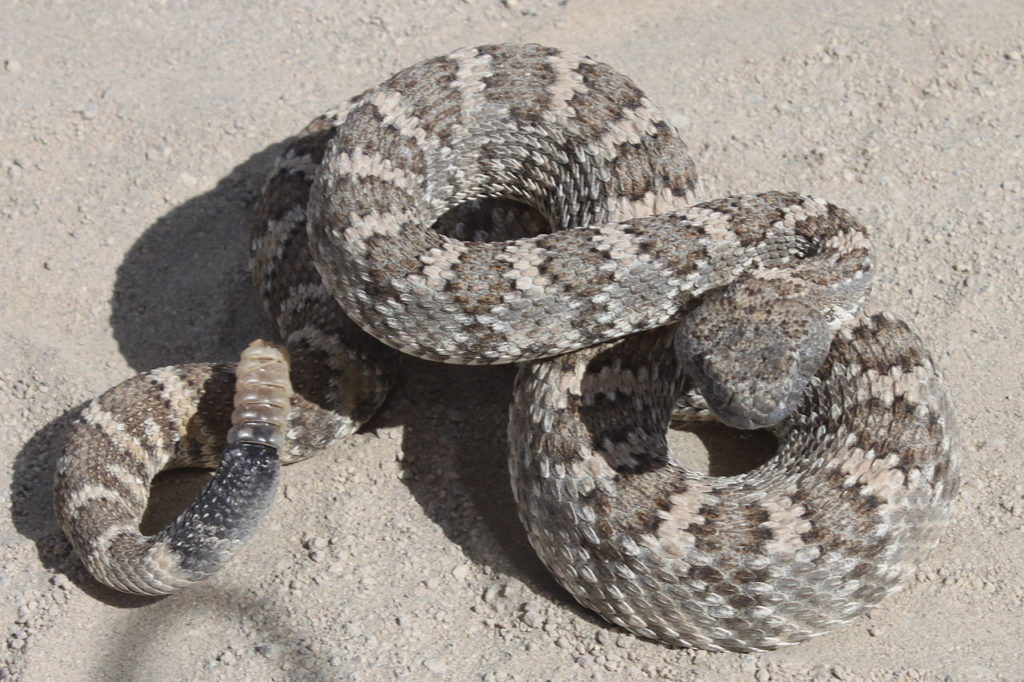
Panamint Rattlesnake
| Scientific Name: | Crotalus stephensi |
| Description: | Adult Panamint Rattlesnakes grow 24 to 36 inches (61 to 91 cm) long. Their background color is tan, buff, brown, or gray. They are also covered with gray, brown, or deep red-brown blotches. |
| Habitat: | Hilly or mountainous regions with scattered rocks. |
| Conservation Status: | Species of least concern. |
Adult Panamint Rattlesnakes average body length is 24 to 36 inches (61 to 91 cm). Their background color is tan, buff, brown, or gray. They are also covered with gray, brown, or deep red-brown blotches. They sometimes have gray highlights on the sides of the body and head. They also have black-tipped scales on their backs, particularly at the blotches’ edges.

Where Do Panamint Rattlesnakes Live in Nevada?
Panamint Rattlesnakes are commonly seen in hilly or mountainous regions with scattered rocks. In cooler temperatures, they migrate to lower desert areas. Specifically, the Panamint Rattlesnake inhabits the mountains and foothills of southwest Nevada.
How Dangerous Are Panamint Rattlesnakes?
A Panamint Rattlesnake’s venom is hemotoxic. Envenomation from one of these snakes can lead to various symptoms. These include significant pain and swelling at the bite site. Nausea and vomiting might also occur. It can affect blood clotting and lead to excessive bleeding. It may induce shock, leaving the victim feeling weak and disoriented. It’s crucial to seek immediate medical help if bitten by a Panamint Rattlesnake. Source

Mojave Rattlesnake
| Scientific Name: | Crotalus scutulatus |
| Description: | Adult Mojave rattlesnakes grow 2 to 4 ft (about 0.61 to 1.22 m) in length. Their base color varies in shades of brown, olive green, dark green, and tan. Along their backs are dark diamond-like spots. |
| Habitat: | Mojaves prefer high deserts (500 – 5,000 ft. elevation) and lower mountain slopes. |
| Conservation Status: | Species of least concern. |
Adult Mojave rattlesnakes typically measure 2 to 4 ft (about 0.61 to 1.22 m) in length. These snakes sport a base color that varies in shades of brown, olive green, dark green, and tan. Along their backs, they feature a distinctive dark brown diamond-like pattern. Their tails are white and black banded. This adds to their unique appearance.
Other common names are Mojave Green Rattlesnake and Northern Mohave Rattlesnake.

Where Do Mojave Rattlesnakes Live in Nevada?
Mojave rattlesnakes are found in the southern 4 counties of Nevada. These snakes are the least common of Nevada’s 6 rattlesnakes. They do occur in close proximity to some of southern Nevada’s urban sprawl, though. They are seen in Eldorado Valley. They also inhabit the territory surrounding Lake Mead.
Mojaves prefer high deserts (500 – 5,000 ft. elevation) and lower mountain slopes. They like desert flats instead of areas with high volumes of vegetation or rocky areas.
How Dangerous Are Mojave Rattlesnakes?
Mojave rattlesnakes have highly potent venom. They are one of the state of Nevada’s most dangerous snakes.
Their venom is either hemorrhagic/hemotoxic or neurotoxic. The type of venom the snake has depends on the area it lives in. Their hemorrhagic venom prevents blood clotting and destroys body tissue. On the other hand, their neurotoxic venom is even more dangerous. It shuts down the nervous system. Victims of neurotoxic venom may become paralyzed. Furthermore, they can lose the ability to breathe. Source
Also, see: Bears in Nevada – Krebs Creek
Wild Cats In Nevada – Krebs Creek
Bonneville Cutthroat Trout in Nevada – Krebs Creek
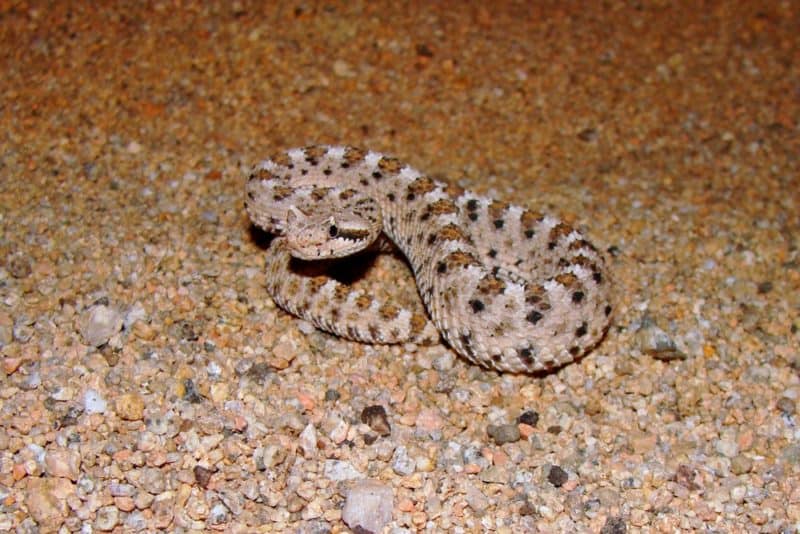
Mojave Desert Sidewinder
| Scientific Name: | Crotalus cerastes cerastes |
| Description: | An adult Mojave sidewinder measures 17 to 31 inches in length. Their base color varies from cream, buff, or ash gray. Overlayed with dark brown spots. |
| Habitat: | They prefer sandy areas. |
| Conservation Status: | State priority species. Unprotected |
The sidewinder’s defining characteristic is its mode of travel. These snakes get their name from their peculiar sideways form of locomotion. They lead with their midsections instead of their heads. It turns out that this is a much more effective way to move across the sand. They are fast-moving snakes and can reach speeds of up to 18 mph.
The adult sidewinder measures 17 to 31 inches in length, with the female being the largest. Their base color varies from cream, buff, yellowish-brown, pink, or ash gray. It is overlaid with 28 to 47 dorsal blotches. The belly is white, and the adult’s proximal lobe of the rattle is brown. Sidewinders are unique in that they have the ability to change their coloration. Other species, such as chameleons and Arizona Black rattlesnakes, share this ability. The process of doing this is metachrosis.
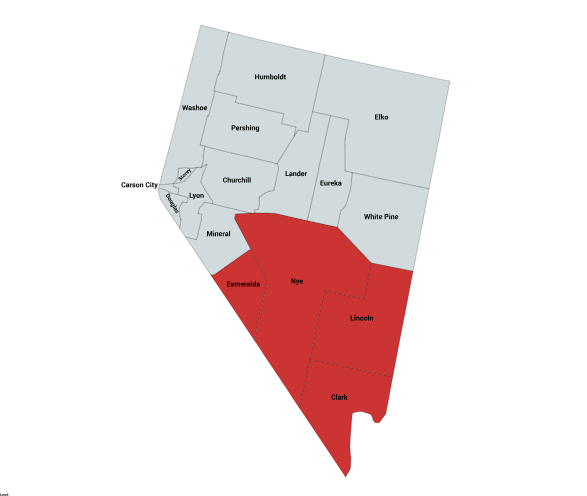
Where Do Mojave Desert Sidewinders Live in Nevada?
Mojave Desert Sidewinders are found in the southern regions of Nevada.
How Dangerous Are Sidewinders?
The Sidewinder rattlesnake is venomous, but its venom is weaker than other rattlesnakes. Their smaller venom glands make them less dangerous than their larger relatives. You should still be wary of them because any rattlesnake bite can be fatal. If bitten, you should seek medical attention immediately.
Sidewinders can’t inject enough venom in one bite to create severe complications. However, it’s more serious if the victim gets envenomated multiple times. If medical treatment is delayed, the following complications could occur.
- Internal bleeding
- Deep tissue damage may lead to bacterial infections and gangrene.
- Loss of use of the affected limb
- Severe shock
- Paralysis
- Seizures
- Coma
- Multiple organ failure source
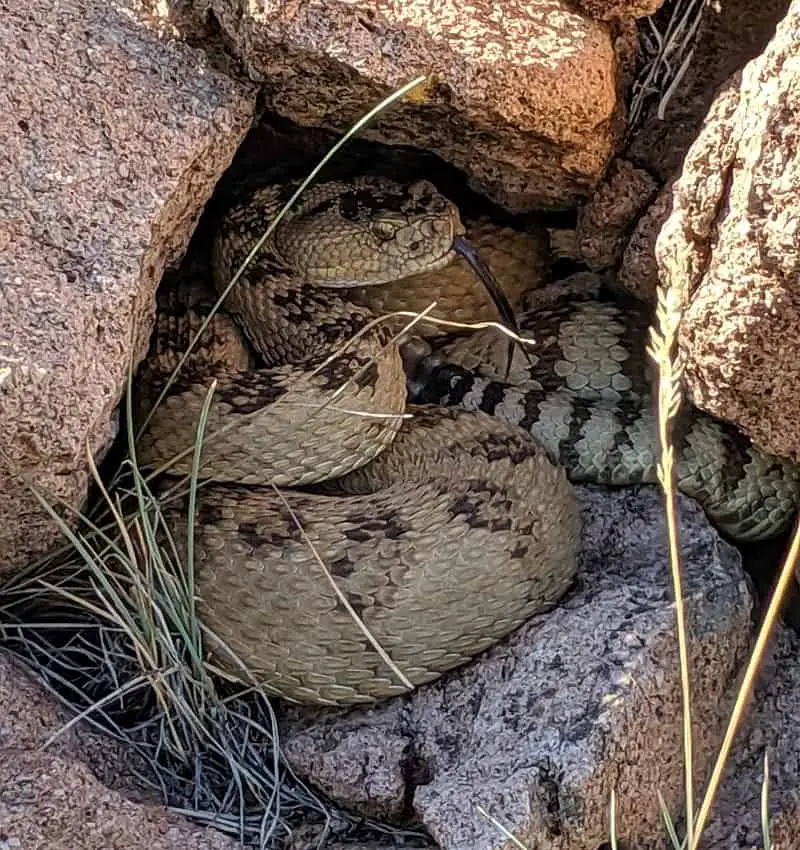
Great Basin Rattlesnake
| Scientific Name: | Crotalus oreganus lutosus |
| Description: | Adults grow 3 to 4 feet (.91 to 1.22m) long. Their bodies are light gray or brown with dark blotches. |
| Habitat: | Juniper forests, age-low banks, and rocky outcrops. |
| Conservation Status: | Species of least concern. Most common rattlesnake in Nevada. |
The Great Basin Rattlesnake is a subspecies of the Western rattlesnake. See,
These snakes’ bodies are light gray or light brown. Their bodies are also covered with dark blotches. These blotches are dark brown to black with pale centers. These rattlesnakes rarely exceed 3 feet (.91 m) in length. However, the largest specimens grow to 4 feet (1.22 m).
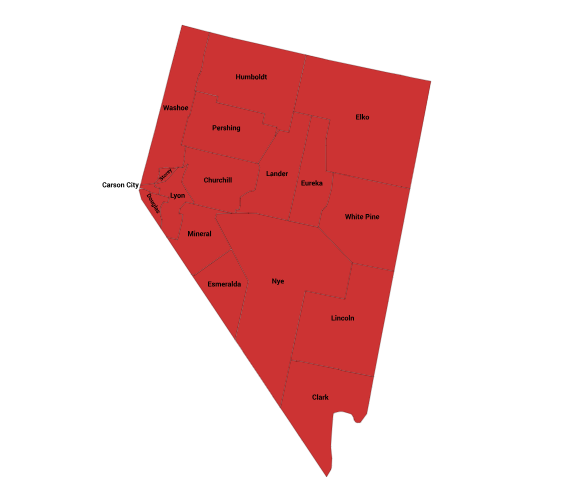
Where Do Great Basin Rattlesnakes Live in Nevada?
Great Basin Rattlesnakes have a variety of habitats in which they can live and survive. These include juniper forests, sage-brush steppes, and rocky outcrops. In Nevada, the Great Basin Rattlesnake lives throughout most of the state.
How Dangerous Are Great Basin Rattlesnakes?
Great Basin Rattlesnake venom is a potent mix of myotoxins and hemotoxins. Their bites may produce pain, edema, nausea, and vomiting. Furthermore, the hemotoxic part of their venom can cause internal bleeding. This may lead to multiple organ damage. Moreover, the myotoxic part of their venom will produce necrosis of body tissue. Source
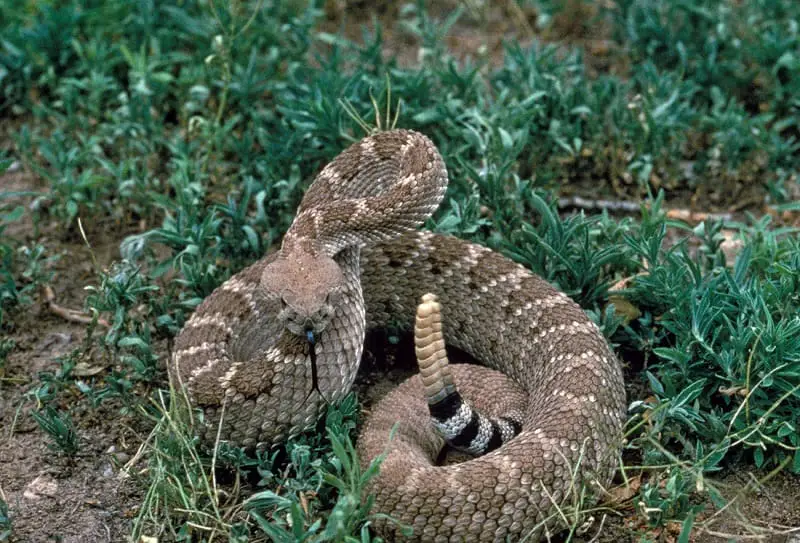
Western Diamondback Rattlesnake
| Scientific Name: | Crotalus atrox |
| Description: | Adults range from 4 to 7 ft (1.22 to 2.13m) long. Their base color ranges from yellow, light brown, salmon, gray, or olive. |
| Habitat: | Inhabit flat coastal plains, steep rocky canyons, and hillsides. |
| Conservation Status: | Species of least concern. |
The Western Diamondback is the largest of the southwestern desert rattlesnakes. They grow from 4 to 7 ft (1.22 to 2.13m) long. They have dark diamond-shaped patterns along their backs. This is why they have the name “Diamondback.” A dark line runs from the corner of the mouth to behind the eye. Their base color varies from yellow, light brown, salmon, gray, gray-brown, cream, or olive. The edges of their dorsal spots are darker, with the centers slightly darker than the base color. Their tail has two to eight black bands separated by pale gray bands.
This species has various names, including the Western Diamond-backed Rattlesnake and Adobe Snake.

Where Do Western Diamondback Rattlesnakes Live in Nevada?
Western Diamondback Rattlesnakes live in extreme southern Nevada in Clark County.
How Dangerous Are Western Diamondback Rattlesnakes?
Western Diamondback rattlesnake venom is hemotoxic, cytotoxic, and myotoxic. If a Western Diamondback bite goes untreated, it can cause serious problems. These include severe internal bleeding and tissue damage, which might result in gangrene. Source
Symptoms of Venomous Snake Bites
Some of the symptoms you may experience from a venomous snake bite include:
- Discoloration in the area of the bite.
- Swelling in the area of the bite.
- Loss of muscle coordination.
- Tingling sensation in the area of the bite.
- Feeling nauseous.
- Having an abnormally rapid pulse.
What Should You Do if You Are Bitten?
If you or someone you are with has suffered a venomous snakebite, time is of the essence. Because the sooner a victim receives antivenom, the less chance the venom in their body has to cause harm. In other words, it is important to seek immediate medical help.
Do not attempt to kill the snake for identification purposes. This gives the snake a chance to bite you again. Also, consider that severed snakeheads can still bite and envenomate and often do. If you have a phone, take a photo of the snake. Otherwise, get started on your way to the nearest hospital.
First Aid for Snake Bite Victims
- Remain calm and limit your movements. Do not run. If you must hike back to a vehicle, do it calmly and deliberately. Put as little stress on your heart as possible.
- Keep the area of the snake bite below the heart level and never above the heart level. Keeping the bite below the heart level will reduce the venom’s flow. However, holding the bite above your heart level will increase the venom’s flow.
- Remove all constricting items such as bracelets, watches, or rings before swelling occurs.
- Remember that using a cold compress on a venomous snake bite is not advisable. The cold may cause the local blood vessels to constrict and spread the venom faster.
- You can wash the affected area like any other wound with soap and water.
- You may cover the bite area with a moist dressing to reduce the swelling.
- Get medical attention as soon as possible. Call the hospital to tell them a venomous snake has bitten you. So they can have antivenom ready to give you as soon as you arrive.
- A person whom a venomous snake has bitten may go into shock. If this happens, lay them flat and cover them with a blanket.
Dressing for Snake Country
- Thick socks, High-top leather boots, and long pants are wise ideas.
- Also, wear loose-fitting denim. If there’s a gap before the snake’s fangs touch your skin, your chances of being envenomated are lower.
- In the absence of high-top leather boots, some people wear snake gaiters.
Rattlesnake Predators
Rattlesnake Predators That Are Immune to Rattlesnake Venom
Although they are venomous, rattlesnakes do have some predators.
- Two of these are the California Kingsnake and the Common Kingsnake. Both of these snakes, which kill by constriction, are somewhat immune to snake venom.
- Skunks also prey on rattlesnakes. Fortunately for them, they are also immune to snake venom.
- Badgers also eat rattlesnakes and have some immunity to rattlesnake venom.
- Feral hogs are also immune to snake venom and find rattlesnakes to be tasty snacks.
Rattlesnake Predators That Are Not Immune to Rattlesnake Venom
The following animals prey on rattlesnakes on occasion but are not immune to their venom. They have to manage to kill the snake without being bitten.
- Coyotes
- Bobcats
- Mountain lions
- Raptors
- Roadrunner
- Javelina-Javelinas do not eat rattlesnakes. However, they do kill them.
Recent Posts
The only venomous snakes in Washington State are Northern Pacific Rattlesnakes. The Northern Pacific Rattlesnake (Crotalus oreganus oreganus) is a sub-species of the Western Rattlesnake. Anyone...
Skunks are not classified as true hibernators. But they go into a state of torpor when the weather gets cold. Skunks are light sleep hibernators, along with opossums, bears, and raccoons. ...
